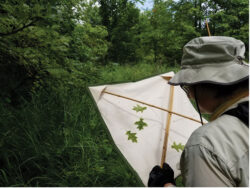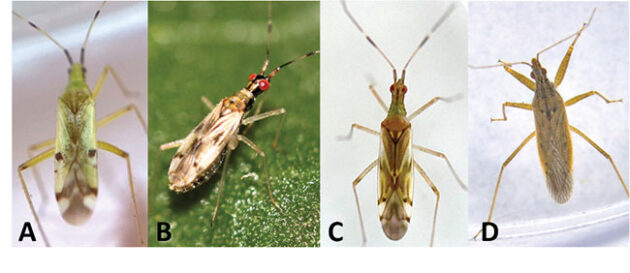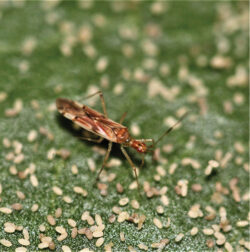
Features
Native Canadian hemipteran predators of greenhouse pests
To get the most out of your greenhouse biocontrol program, start with preventative strategies.
October 20, 2022 By R. Labbe, L. Des Marteaux, J. Mlynarek, S. VanLaerhoven, P. Desloges Baril, C. Demers, A. Laflair, D. C. Fernández
 Surveyors of native predatory hemipterans across Ontario. Clockwise from top left: Dr. Rose Labbe, Paige Desloges Baril, Andrew Laflair, Dr. Julia Mlynarek.
PHOTOS: AGRICULTURE AND AGRI-FOOD CANADA.
Surveyors of native predatory hemipterans across Ontario. Clockwise from top left: Dr. Rose Labbe, Paige Desloges Baril, Andrew Laflair, Dr. Julia Mlynarek.
PHOTOS: AGRICULTURE AND AGRI-FOOD CANADA. Among the diversity of biological control agents employed in greenhouses, hemipteran predators represent some of the most economically important and well-suited natural enemies. These predators can offer excellent crop protection on challenging host plants such as tomato, whose trichomes and chemical secretions present a barrier for establishment of many other beneficial arthropod species. For instance, hemipteran predators in Europe proved to be effective at mediating crop damage by the invasive tomato leafminer, Tuta absoluta, because they could persist on tomato and feed heavily on leafminer eggs and larvae.
The tomato leafminer has spread rapidly from South America across Europe, Africa, and Asia, causing yield losses of up to 100% for both fresh market and processing tomatoes grown in fields and greenhouses. We therefore began to consider how we could mediate the potential threat of this pest in Canada. In today’s global regulatory environment, the importation of non-native biocontrol agents into new areas is highly restricted, owing to concerns of non-target effects by such introduced species. As such, finding new agents to target the plethora of native and invasive greenhouse crop pests requires us to first explore the species we have available locally.
Hemipteran survey: Four years of field collections across Ontario
Between 2018 and 2021 we completed extensive surveys of natural and agricultural areas across Ontario to identify predatory hemipterans that can be easily maintained in lab colonies, establish well on greenhouse crops, and demonstrate good control potential for a diversity of arthropod pests (Figures 1 and 2). In total, these surveys yielded over 1,300 predatory hemipteran individuals across sites in northern and southern Ontario. Among the insects collected, we identified and successfully established colonies for several native predatory hemipterans: two predatory nabids (Nabis americoferus and Hoplistocelis pallescens) and three predatory mirids (Dicyphus discrepans, Dicyphus famelicus, and Macrolophus tenuicornis) (Figure 3).

Figure 2.
Dr. Julia Mlynarek collects target insects from a ‘beat sheet’ during her survey.
Studying species of interest: D. discrepans, D. famelicus, M. tenuicornis, N. americoferus, H. pallescens
To date, we have characterized the life histories (adult lifespans, number of offspring produced by females over their lifetime) for D. famelicus, D. discrepans, and N. americoferus. We have also assessed their predatory capacities against eggs of Ephestia kuehniella (the Mediterranean flour moth) and are completing similar trials on eggs and first larval instars of another lepidopteran pest, Trichoplusia ni (cabbage looper); both moths serving as our proxies for T. absoluta. We confirmed that the mirids D. famelicus and D. discrepans successfully develop on tomato and can establish at the greenhouse level. Life history characterizations and predatory capacity trials for M. tenuicornis and H. pallescens are currently underway.

Figure 3:
Some of the native predatory hemipterans collected through surveys and now under study at the Harrow Research and Development Centre. A. Macrolophus tenuicornis, B. Dicyphus discrepans, C. Dicyphus famelicus, D. Nabis americoferus.
Adult female D. famelicus and D. discrepans live for 60 to 75 days, laying an average of 124 and 75 eggs over their lifespans, respectively. By comparison, D. hesperus – a commercially available biocontrol agent and close relative of our mirids – lives approximately 51 days and lays an average of 63 eggs over their lifespan. Adult female N. americoferus survive approximately 58 days (up to 112 days) and can produce an average of 43 offspring in their lifetime. Dicyphus famelicus and D. discrepans consume roughly 42 flour moth eggs per day (Fig. 4), while N. americoferus can consume an average of 56 flour moth eggs per day. Dicyphus famelicus and D. discepans consume an average of 4.6 and 2.1 first instar cabbage larvae per day, respectively.

Figure 4:
A sea of snacks: Dicyphus famelicus consumes one of many Mediterranean flour moth eggs.
How do these candidate species compare to hemipterans currently commercialized for use against T. absoluta? The biocontrol agents Macrolophus pygmaeus and Nesiodicoris tenuis reportedly consume an average of 50 T. absoluta eggs per day. However, Mediterranean flour moth eggs (1.27 mg) weigh nearly double that of T. absoluta eggs (0.67 mg). Taking the difference in mass into consideration, our mirids consume the equivalent of roughly 80 T. absoluta eggs per day, while N. americoferus could consume over 100 T. absoluta eggs per day. Similarly, as first instar cabbage loopers weigh roughly three times that of first instar T. absoluta, our mirids likely exceed the moth larvae consumption rates of M. pygmaeus and N. tenuis (an average of 2 T. absoluta larvae per day).
Among our five candidate hemipteran predators we are therefore confident that at least some will be effective biocontrol agents against T. absoluta, and we have confirmed their broader utility by observing that they feed on additional greenhouse pests such as whitefly, spider mites, and thrips. Our ongoing work will determine the feasibility of maintaining colonies of these predators and how quickly they might establish in greenhouse crops, which is foundational for commercial development and application of biocontrol agents in Canadian greenhouses.
Future work: Impact on the greenhouse sector
We are thrilled to have identified promising, novel, and native hemipteran biocontrol species for future commercial availability in Canada. We set our future sights on characterising these predators’ pest control range and optimising their mass rearing protocols, release schedules, and greenhouse placement. We will also determine whether large populations of these predators can damage greenhouse crops; a known drawback of other mirids such as N. tenuis.
We expect that these predators will have a significant value for commercial greenhouses nationally and abroad, and hope they will contribute to the overall sustainability of pest management in greenhouse environments. We are now also in conversation with prospective industry partners who may help to accelerate commercialization of these species.
Print this page